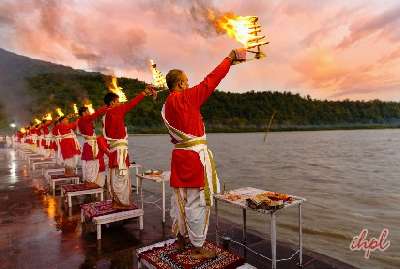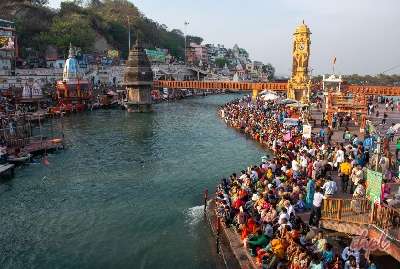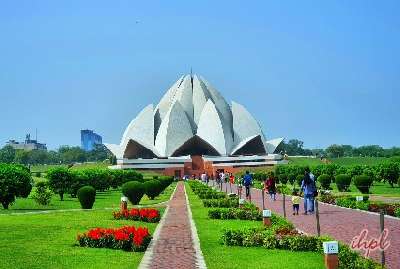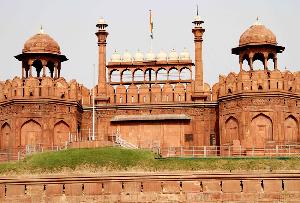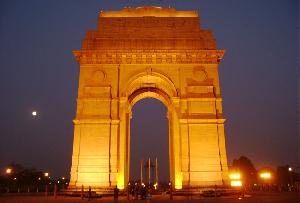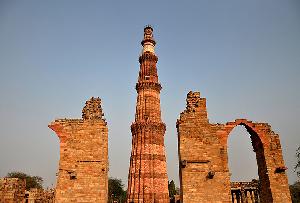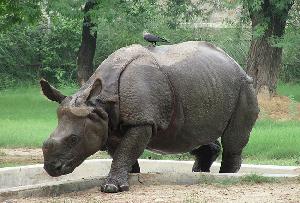Digambar Jain Temple is the oldest temple of the Jain religion in Delhi. It is located just opposite the massive Red Fort at the point where Netaji Subhas Marg intersects the Chandni Chowk. Originally built in 1526, the temple has received many modifications and additions several times. The structure was expanded in the early 19th century. The imposing red sandstone temple is also known as Lal Mandir.
- An abode of peace and sanctity, the main devotional area resides on the first floor.
- A small courtyard which is encircled by an arcade, leads to the terrace. The devotional area is reached by ascending to the terrace.
- The main shrine is of Lord Mahavira, the 24th Tirthankara of Jainism. Apart from this, this area features a number of other shrines also.
- The statue of Lord Adinath, the first Tirthankara of the Jain religion is present here.
- The shrine of Lord Parasnath, the immediate predecessor of Lord Mahavira, is also here.
- The shrine area is embellished with engilded paintwork. The glow of the butter lamps and candle lights create a solacing ambience.
- Devotees from all corners of the country throng the temple and make offerings such as fruits, grains, rice and candles.
- The temple complex also holds a bookstore which has a wide collection of rare pieces of literature on Jainism.
- Visitors are requested to remove their shoes and all other leather goods before entering the temple complex.
Life of Lord Mahavira:
Mahavir was born in 599 B.C. as a prince in the ancient republic of Vaishali in Bihar. He became a monk at the age of 30, abandoned his family and royal household and gave up all his material possessions including clothing. The eternal quest for salvation was the guiding force behind his transformation.
He spent the next twelve years in deep meditation to overcome his desires and feelings. His days of austerities involved going without food for long periods and avoiding harming or annoying any living beings including animals, birds, and plants. After he attained the Enlightenment, he spent the rest of his life preaching to people about the eternal truth of life and ways to attain salvation. He spent the next thirty years traveling on bare feet all over the country attracting people from all spheres of life.
He organized his followers, into a four fold order, namely monk (Sadhu), nun (Sadhvi), layman (Shravak), and laywoman (Shravika). Later, they came to be known as the Jains. According to common belief, he was the founder of Jainism but he was actually the reformer of an already existing faith. He reformulated and presented the principles of the religion in a form according to the needs of the period.
The ultimate objective of his precept is how one can achieve the complete freedom from the cycle of birth, life, pain, misery, and death attaining the permanent blissful state of one’s self. He preached that right faith, right knowledge and right conduct together can help attain the liberation of one’s self.
Annual Events:
The Jain community celebrates many social and religious functions annually. These annual events are the holy occasions when devotees from all corners of the country throng the Digambar Jain Temple. This is undoubtedly the best time to visit the temple. Renunciation, austerities, study of the scriptures, repetition of holy hymns, meditation and expressing devotion for the God mark these events.
The important festivals at Digambar Jain Temple are Paryushan, Samvatsari, Deepawali and Jnaan Panchami.
Paryushan
This festival is also known as ‘Paryushan Parva’, celebrated every year in the auspicious month ‘Bhadrapad’ of the Hindu calendar. It can be termed as the festival of self-uplift by the holy observation of ten universal virtues. It extends from the fifth day to fourteenth day of the bright fortnight. The festival requires the devotees to observe the ten universal supreme virtues in their daily life. It aims at the attainment of salvation and a blissful existence in this world and the world after.
Samvatsari
Samvatsari is the last day of Paryushana. It is a common practice for the devout to practice Samayika on this day.
Deepawali
Deepawali is the festival of lights celebrated by Hindus as well as Jains. For Jains, it marks the anniversary of the attainment of liberation by Mahavira at the end of his life on earth in 527 BC.
Jnaan Panchami
Jnana Panchami is observed on the fifth day of the first month of the year. On this day, the scriptures are worshipped with religious devotion. Svädhyäya, meditation, Pratikraman are also performed. Also, the books maintained in the religious libraries are cleansed and restored as necessary.
Fast – Facts:
Here are some facts about the Digambar Jain Temple which would help you to have a quick glance of this famous temple in Delhi. Also, this will make it a lot more convenient for you.
Location
Digambar Jain Temple is located just opposite the massive Red Fort at the intersection of Netaji Subhas Marg and Chandni Chowk.
Built In
The temple was originally built in 1526.
Special Feature
Digambar Jain Temple is a Jain pilgrim center of Digambar sect.
How to Reach
Digambar Jain Temple being located in the capital city, can be reached from any corner of the country.
Nearest International Airport: Indira Gandhi International Airport
Nearest Railway Station: Old Delhi Railway Station
Nearest Metro Station: Delhi Main
Nearest Bus Stop: Local buses from various points
Best Time To Visit
This best time to visit Digambar Jain Temple are during the annual events. The important festivals at the temple are Paryushan, Samvatsari, Deepawali and Jnaan Panchami.
Nearby Attractions:
The places nearby the Digambar Jain Temple are some of the most popular tourist spots in Delhi. If you are planning for a visit to this famous Jain temple, keep some time for a trip to these unique sites. Rich in historical and cultural significance, these places are a must-see.
Nearby Attractions of Digambar Jain Temple in Delhi are Red Fort, Jama Masjid, Chandni Chowk, Salimgarh Fort, Kashmeri Gate, St James Church, Dara Shikoh Library, Lothian Cemetery and Rajghat.
Red Fort
Red Fort is the largest of old Delhi’s monuments. Mughal Emperor Shahjahan started its construction in 1638 and work was completed in 1648. The thick red sandstone walls with turrets and bastions, have government: halls of public and private audience, domed and arched marble palaces, plush private apartments, a mosque, and elaborately designed gardens inside.
Jama Masjid
This is the principal mosque of Old Delhi. Commissioned by the Mughal Emperor Shah Jahan and completed in the year 1656 AD, it is the largest and best known mosque in India.
Chandni Chowk
Located opposite the Red Fort, Chandni Chowk is a market that bustles with activity all through the year. The area was set up by Shahjahan’s daughter, Jahanara. The market has a large number of galis (lanes) and each gali has some thing special about it.
Salimgarh Fort
Salimgarh Fort is adjacent to the Red Fort across the Ring Road. It was built by Sher Shah Suri’s son Salim Shah. It is an island fort encircled by the river Yamuna.
Kashmeri Gate
Kashmeri Gate is located on Lothian Road near the Lothian cemetery on the northeast side of the railway bridge.&
St James Church
St. James Church was built by the famous Colonel James Skinner in a Greek cross design. Consecrated in 1836, this captivating church is believed to be an imitation of St Paul’s Cathedral in London.
Dara Shikoh Library
It was built by Shah Jahan’s liberal son and chosen successor Dara Shikoh. It is now the Dara Shikoh Library of the Department of Archaeology, Delhi Administration.
Lothian Cemetery
This old cemetery is the first British cemetery of Delhi. The members of Delhi’s Christian community were buried here from 1808 to 1867.
Rajghat Mahatma Gandhi was cremated here. A memorial to the Mahatma, Rajghat is a square platform with a black memorial stone with “Hey Ram” inscribed on it.
This is not all. The places near the Digambar Jain Temple have some of the finest places to eat and shop.
Karim Hotel, Ghantewala sweet shop, food stalls near Jama Masjid, Paranthewali Gali, Natraj hotel, Chor Bizarre of Broadway Hotel, Daryaganj’s Flora, Peshwari, Moti Mahal Restaurant, Worker’s canteen of Inter-State Bus terminal and legions of roadside food stalls will give a taste of a lip smacking variety of cuisines including. Of course, the dishes typical to Delhi are not to be missed.
Nai Sarak for books, Chor bazaar for electronic goods, Daryaganj book market on Sunday and Chatta Chowk in Red Fort for traditional and contemporary jewelry and handicrafts are famous spots near the Digambar Jain Temple.





